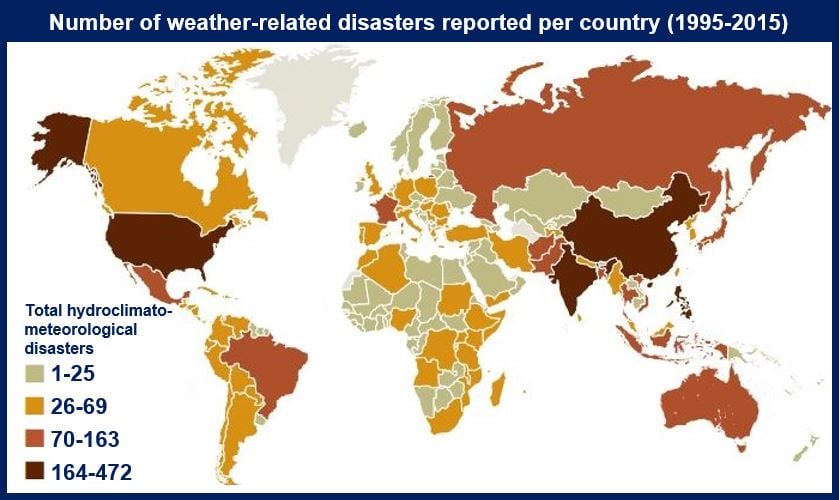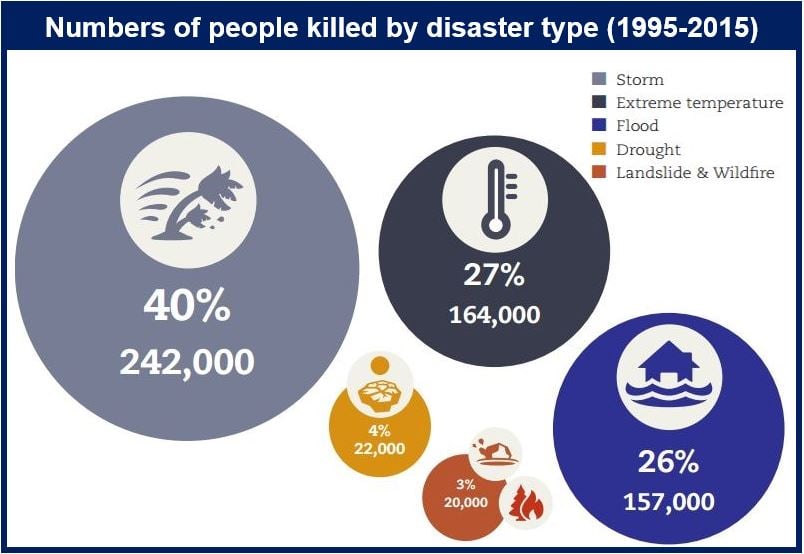There was one weather disaster per day from 2005 to 2014, or 335 each year, twice the rate compared to the 1985 to 1995 decade, and 14% more than 1994 to 2004, says a new United Nations report.
The new report – The Human Cost of Weather Related Disasters – claims that over the past two decades, ninety percent of all major disasters on Earth have been caused by 6,457 recorded storms, heatwaves, floods, droughts and other weather-related events.
The five nations worst affected by the number of disasters are the US with 472, China with 441, India with 288, Philippines with 274 and Indonesia with 163.
 The incidence of weather-related disasters is progressively increasing each decade. (Source: The Human Cost of Weather Related Disasters)
The incidence of weather-related disasters is progressively increasing each decade. (Source: The Human Cost of Weather Related Disasters)
4.1 billion people injured, left homeless or in need of help
The report, compiled by the Belgian-based Centre for Research on the Epidemiology of Disasters (CRED) and the UN Office for Disaster Risk Reduction (UNISDR), informs that since 1995, when the first Climate Change Conference (COP1) was held, a total of 606,000 lives have been lost, and 4.1 billion humans have been either injured, left homeless or in need of emergency assistance because of a weather-related disaster.
The report authors also point out there are some major data gaps, noting that the economic losses linked to weather-related disasters are considerably higher than the official figure of $1.891 trillion, which accounts for 71% of all losses caused by natural hazards over the two-decade period.
Just thirty-five percent of records include data about economic losses. UNISDR estimates that the real figure on disaster losses – including tsunamis and earthquakes – is between $250 billion and $300 billion annually, which is like losing the whole of Ireland’s GDP ($229 billion) each year.
 Weather-related disasters occurred increasingly frequently in the late 1990s, reaching a peak in 2005. Despite a fall in frequency since then, a sustained rise in the number of floods and storms pushed the average annual total up to 335 disasters per annually after 2005, 14% higher than in the previous decade and more than twice the level recorded in 1980-1989. (Source: The Human Cost of Weather Related Disasters)
Weather-related disasters occurred increasingly frequently in the late 1990s, reaching a peak in 2005. Despite a fall in frequency since then, a sustained rise in the number of floods and storms pushed the average annual total up to 335 disasters per annually after 2005, 14% higher than in the previous decade and more than twice the level recorded in 1980-1989. (Source: The Human Cost of Weather Related Disasters)
High price paid in lives lost
Head of UNISDR, Ms. Margareta Wahlström, said regarding the report:
“Weather and climate are major drivers of disaster risk and this report demonstrates that the world is paying a high price in lives lost. Economic losses are a major development challenge for many least developed countries battling climate change and poverty.”
“In the long term, an agreement in Paris at COP21 on reducing greenhouse gas emissions will be a significant contribution to reducing damage and loss from disasters which are partly driven by a warming globe and rising sea levels.”
“For now, there is a need to reduce existing levels of risk and avoid creating new risk by ensuring that public and private investments are risk-informed and do not increase the exposure of people and economic assets to natural hazards on flood plains, vulnerable low-lying coastlines or other locations unsuited for human settlement.”
 (Source: The Human Cost of Weather Related Disasters)
(Source: The Human Cost of Weather Related Disasters)
According to Ms. Wahlström, the development year had started in March 2015 with the adoption of the Sendai Framework for Disaster Risk Reduction, a 15-year-long package endorsed by the United Nations General Assembly, which sets out targets for a significant reduction in disaster losses, including the number of individuals affected, mortality, economic losses and damage to vital infrastructure including hospitals and schools.
Head of CRED, Professor Debarati Guha-Sapir, said:
“Climate change, climate variability and weather events are a threat to achieving the Sustainable Development Goals’ overall target of eliminating poverty.”
“We need to reduce greenhouse gas emissions and tackle other risk drivers such as unplanned urban development, environmental degradation and gaps in early warnings. This all requires ensuring people are risk informed and strengthening institutions which manage disaster risk.”
Some key details from the report
Asia: accounts for the bulk of the disaster impacts, including 3.7 billion individuals affected and 332,000 deaths.
The Asian death toll includes 138,000 people who died from the devastation caused by Cyclone Nargis, which struck Myanmar in 2008.
According to CRED’s Emergency Events Data Base (EM-DAT), 87 million homes were either destroyed or damaged over the period of the survey.
Floods: during the 1995 to 2015 decade, floods accounted for 47% of all weather-related disasters, which affected 2.3 billion people and took 157,000 lives.
Storms: – the most deadly type of weather-related disaster, accounted for 242,000 deaths, or 40% of all weather-related deaths globally. Eighty-nine percent of these deaths occurred in lower-income nations.
Extreme Temperatures: of the 164,000 lives lost because of extreme temperatures, 148,000 were from heatwaves. Ninety-two percent of deaths from heatwaves occurred in the advanced economies – 90% of them in Europe.
Droughts: EM-DAT, which recorded 136 droughts between 1995 and 2015 in Africa, said the continent is the worst affected by droughts. Seventy-seven of all droughts occurred in East Africa alone.
The authors stressed that data collection on indirect deaths from drought needs to be improved.
